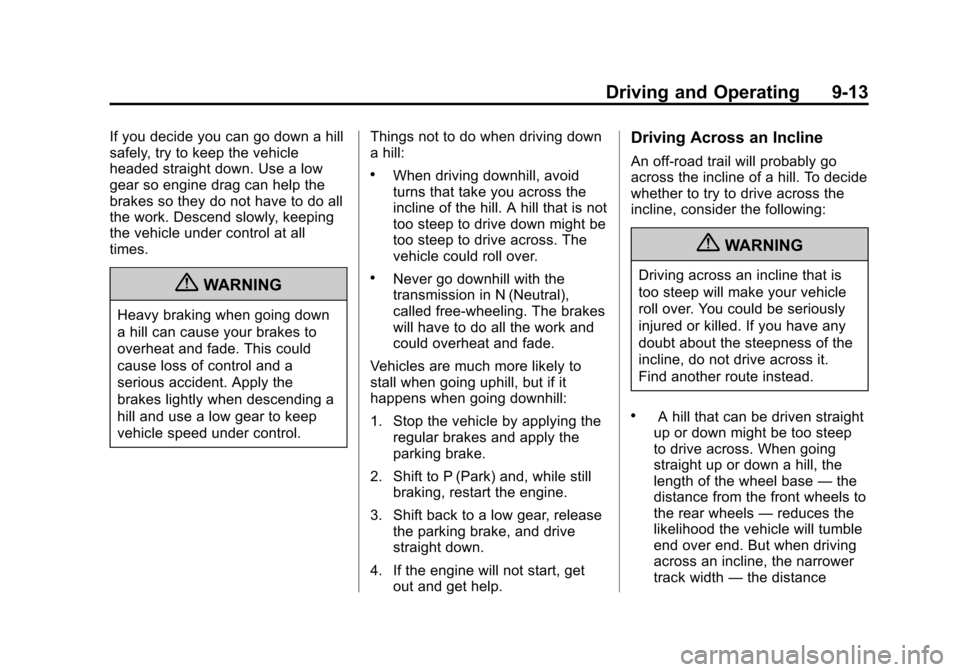Page 187 of 392

Black plate (13,1)Chevrolet Colorado Owner Manual - 2011
Driving and Operating 9-13
If you decide you can go down a hill
safely, try to keep the vehicle
headed straight down. Use a low
gear so engine drag can help the
brakes so they do not have to do all
the work. Descend slowly, keeping
the vehicle under control at all
times.
{WARNING
Heavy braking when going down
a hill can cause your brakes to
overheat and fade. This could
cause loss of control and a
serious accident. Apply the
brakes lightly when descending a
hill and use a low gear to keep
vehicle speed under control.Things not to do when driving down
a hill:
.When driving downhill, avoid
turns that take you across the
incline of the hill. A hill that is not
too steep to drive down might be
too steep to drive across. The
vehicle could roll over.
.Never go downhill with the
transmission in N (Neutral),
called free-wheeling. The brakes
will have to do all the work and
could overheat and fade.
Vehicles are much more likely to
stall when going uphill, but if it
happens when going downhill:
1. Stop the vehicle by applying the regular brakes and apply the
parking brake.
2. Shift to P (Park) and, while still braking, restart the engine.
3. Shift back to a low gear, release the parking brake, and drive
straight down.
4. If the engine will not start, get out and get help.
Driving Across an Incline
An off-road trail will probably go
across the incline of a hill. To decide
whether to try to drive across the
incline, consider the following:
{WARNING
Driving across an incline that is
too steep will make your vehicle
roll over. You could be seriously
injured or killed. If you have any
doubt about the steepness of the
incline, do not drive across it.
Find another route instead.
.A hill that can be driven straight
up or down might be too steep
to drive across. When going
straight up or down a hill, the
length of the wheel base —the
distance from the front wheels to
the rear wheels —reduces the
likelihood the vehicle will tumble
end over end. But when driving
across an incline, the narrower
track width —the distance
Page 245 of 392

Black plate (5,1)Chevrolet Colorado Owner Manual - 2011
Vehicle Care 10-5
If doing some of your own service
work, use the proper service
manual. It tells you much more
about how to service the vehicle
than this manual can. To order the
proper service manual, seeService
Publications Ordering Information
on page 13‑13.
This vehicle has an airbag system.
Before attempting to do your own
service work, see Servicing the
Airbag-Equipped Vehicle on
page 3‑36.
Keep a record with all parts receipts
and list the mileage and the date of
any service work performed. See
Maintenance Records on
page 11‑10.Hood
To open the hood, do the following:
1. Pull the handle with this symbol on it. It is located inside the
vehicle on the lower left side of
the instrument panel.
2. Release the secondary latch on the hood. It is located below the
front center of the hood.
3. Lift the hood.
4. Release the hood prop from its retainer and put the hood prop
into the slot in the hood. Before closing the hood, be sure all
the filler caps are on properly. Then
lift the hood to relieve pressure on
the hood prop. Remove the hood
prop from the slot in the hood and
return the prop to its retainer. Lower
the hood 25 to 30 cm (10 to 12 in)
above the vehicle and release it to
latch fully. Check to make sure the
hood is closed and repeat the
procedure if necessary.
Page 277 of 392
Black plate (37,1)Chevrolet Colorado Owner Manual - 2011
Vehicle Care 10-37
8. Push the bulb socket straight inand turn it clockwise to secure it
in the headlamp assembly.
Front Turn Signal,
Parking, and Daytime
Running Lamps (DRL)
To replace one of these bulbs:
1. Open the hood. See Hood on
page 10‑5.
2. Reach in to access either one of the bulb sockets in the engine
compartment. 3. Turn the bulb socket
counterclockwise and remove it
from the lamp assembly.
4. Holding the socket, pull the old bulb to release it from the bulb
socket.
5. Push the new bulb into the socket until it clicks.
6. Push the bulb socket straight into the lamp assembly and turn
it clockwise to secure.
Taillamps, Turn Signal,
Stoplamps, and Back-Up
Lamps
A. Stoplamp/Taillamp
B. Turn Signal/Taillamp
C. Back‐up Lamp
Page 351 of 392

Black plate (7,1)Chevrolet Colorado Owner Manual - 2011
Service and Maintenance 11-7
UsageFluid/Lubricant
Hydraulic Clutch System Hydraulic Clutch Fluid (GM Part No. 12345347, in Canada 10953517) or
equivalent DOT-3 brake fluid.
Key Lock Cylinders Multi-Purpose Lubricant, Superlube (GM Part No. 12346241, in
Canada 10953474).
Chassis Lubrication Chassis Lubricant (GM Part No. 12377985, in Canada 88901242) or
lubricant meeting requirements of NLGI #2, Category LB or GC-LB.
Front and Rear Axle SAE 75W-90 Synthetic Axle Lubricant (GM Part No. 89021677, in
Canada 89021678).
Transfer Case Synchromesh Transmission Fluid (GM Part No. 12345349, in
Canada 10953465).
Rear Driveline Center Spline and Universal Joints Chassis Lubricant (GM Part No. 12377985, in Canada 88901242) or
lubricant meeting requirements of NLGI #2, Category LB or GC-LB.
Constant Velocity Universal Joint Chassis Lubricant (GM Part No. 12377985, in Canada 88901242) or
lubricant meeting requirements of NLGI #2, Category LB or GC-LB.
Hood Latch Assembly, Secondary Latch, Pivots, Spring Anchor, and
Release Pawl Lubriplate Lubricant Aerosol (GM Part No. 12346293, in Canada 992723)
or lubricant meeting requirements of NLGI #2, Category LB or GC-LB.
Hood and Door Hinges, Body Door Hinge Pins, Liftgate Hinge and
Linkage, Folding Seats, and Fuel
Door Hinge Multi-Purpose Lubricant, Superlube (GM Part No. 12346241, in
Canada 10953474).